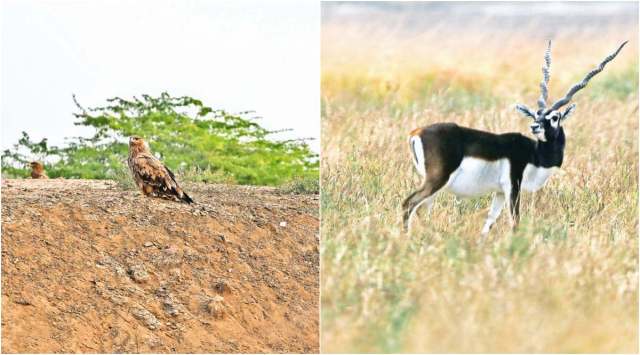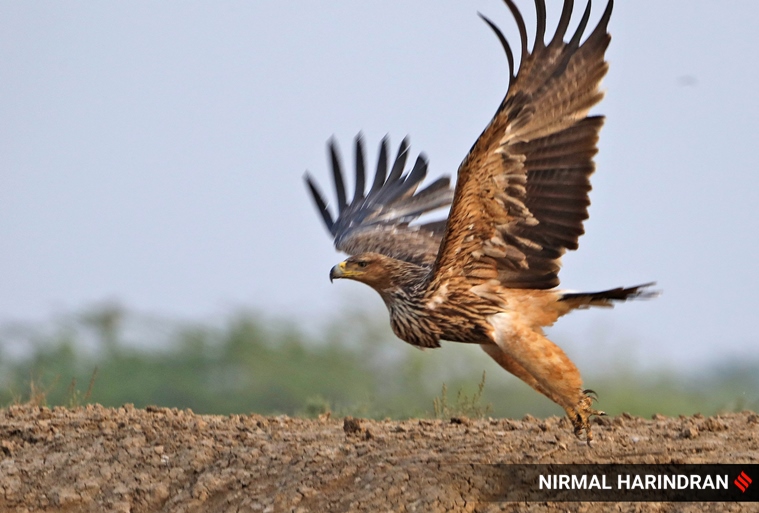- India
- International
At Bhavnagar national park, blackbucks get a mound of relief from annual floods
The national park spread over 35 square kilometres (sq km) is home to around 3,000 blackbucks, more than five dozen Indian gray wolves, around 30 hyenas and thousands of birds of around 300 species, dozens of them international migratory, keep the environment chirpy here.
 Greater spotted eagles on a mound in BNP; (right) a male blackbuck in the area. (Photo: Nirmal Harindran)
Greater spotted eagles on a mound in BNP; (right) a male blackbuck in the area. (Photo: Nirmal Harindran)ON A cold winter evening, a large herd of blackbucks sun on an elevated structure on the northern boundary of Blackbuck National Park (BNP) in Velavadar of Bhavnagar district. On a similar structure on the bank of Alang river on the southern boundary of the park perch a small group of greater spotted eagles.
These large elevated structures — mounds of soil — are the latest habitat tweak done by the Gujarat forest department in the national park dedicated to blackbuck conservation to help the antelopes escape the annual floods.
The national park spread over 35 square kilometres (sq km) is home to around 3,000 blackbucks, more than five dozen Indian gray wolves, around 30 hyenas and thousands of birds of around 300 species, dozens of them international migratory, keep the environment chirpy here. It is the world’s largest communal roosting ground for harriers which land in Velavadar from Europe, Africa and Siberia for wintering. It is also the largest breeding ground of lesser floricans, the endangered species of bustard family, in Gujarat as of today.
 A Greater spotted eagle takes off from a newly-created soil mound at the Blackbuck National Park.
A Greater spotted eagle takes off from a newly-created soil mound at the Blackbuck National Park.
But the BNP lies in Bhal, the low-lying region which is the delta of a number of rivers of Saurashtra region. Local forest officers say that about of 70 per cent of the BNP gets flooded in events of continued heavy rainfall in Amreli, Bhavnagar, Rajkot and Botad as rivers originating from these districts submerge areas of Velavadar as well as a number of other villages in this region.
Unlike their cousins swap deers, blackbucks find it difficult to move in marshlands and swaps.

As per official records, between 2011 and 2021, as many as 111 blackbucks died due to drowning or falling prey to stray dogs when they headed towards villages to flee the floods. The last three years accounted for 89 of those deaths. As per official records, 38 blackbucks died due to drowning or dog attacks during flooding in 2019-20 when Saurashtra recorded 155 per cent rainfall and 35 in 2020-21 when rainfall was 184.63 per cent. But the number fell to 16 in 2021-22 even as rainfall also dropped to 116.15 per cent. The number of blackbucks died during floods in 1982 and 2007 — when the monsoon rains were unusually high — are 300 and around 200 respectively.
 Blackbucks graze near a soil mound.
Blackbucks graze near a soil mound.
Local forest staff say that the majority of blackbucks start moving to the internal mud tracks built by the forest department after it starts raining while others seek shelter in thickets of gando baval (prosopis juliflora).
“Blackbucks generally avoid water. They can swim short distances but they remain vulnerable at the beginning of the monsoon, having weakened during the long dry summer. So, some fail to swim to safety but a majority can’t survive attacks by dogs due to weakness,” says Harpalsinh Chudasama, a forester serving at the BNP for the past 25 years.
Prof Indra Gadhvi, head of department of marine science at the Maharaja Krushnakumarsinhji Bhavnagar University in Bhavnagar says waterlogging in the region has increased in recent years after the development of highways and villages, agricultural fields and saltpans.
The forest department responded to the phenomenon by creating nine large soil mounds and a linear platform last summer. Five of these mounds have been created along the bank of Alang and Parvalia rivers within the BNP boundaries and four in revenue areas where the blackbucks have settled. These mounds of 50 metre diameter at base and 30 metre at top in the BNP have been created by utilising funds provided by the NHAI under wildlife mitigation measures for the ongoing widening of NH 751.
“Creating soil mounds is not a new thing per say. We used to do it earlier also. When the area gets flooded, animals can seek shelter on these mounds,” Shyamal Tikadar, principal chief conservator of forests (wildlife) says.
But the mounds created last summer, the first to be created after 2014-15, are quite large as compared to those created in the past. Average 4,000 cubic metre of soil has been used to create each one of them and they rise average six feet above the surrounding area. Some of them have been stone-pitched to prevent erosion.
Dushyant Vasavada, chief conservator of forests (CCF) of Junagadh wildlife circle says the comparatively low number of casualties in the current year is partially due to these mounds.
“It is a result of both-the level of flooding and the mounds, which we call platforms…. But intensity and duration of rains, level of floods are also important factors (which vary year to year) and therefore, the casualty varies,” says the CCF in whose jurisdiction the BNP falls.
Local forest officers say they observed herds of blackbucks seeking refuge on these mounds during flooding in the area this monsoon. “We try to tempt them to these mounds by unloading grass over there,” says Mahesh Trivedi, assistant conservator of forests (ACF) of BNP.
Prof Gadhvi, who has studied the BNP ecology extensively, agrees such mounds can be effective. “If you see the record of 1982 floods and afterwards, because of these mounds, many of the animals have been saved,” he says.
Apr 27: Latest News
- 01
- 02
- 03
- 04
- 05








































